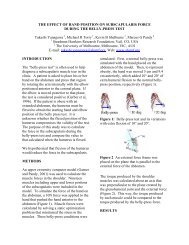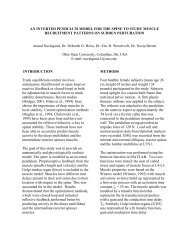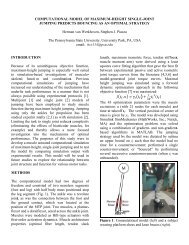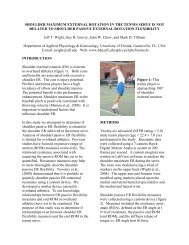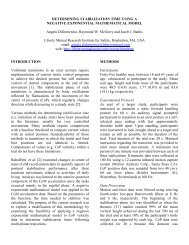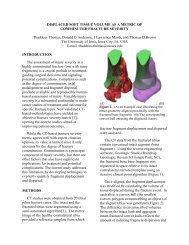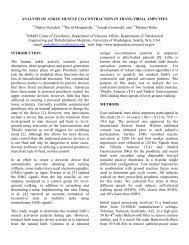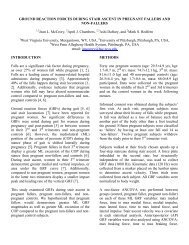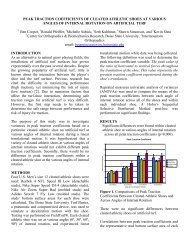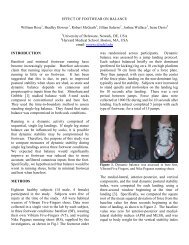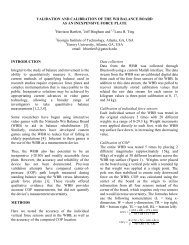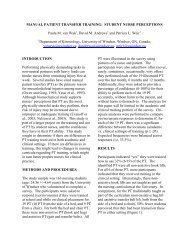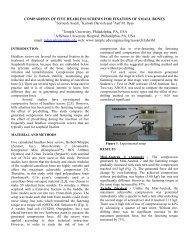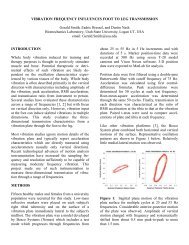Validation of a real-time markerless tracking system - American ...
Validation of a real-time markerless tracking system - American ...
Validation of a real-time markerless tracking system - American ...
Create successful ePaper yourself
Turn your PDF publications into a flip-book with our unique Google optimized e-Paper software.
INTRODUCTION<br />
<strong>Validation</strong> <strong>of</strong> a <strong>real</strong>-<strong>time</strong> <strong>markerless</strong> <strong>tracking</strong> <strong>system</strong> for clinical gait analysis<br />
- ad hoc results -<br />
1 Kai Daniel Oberländer, 1 Gert-Peter Brüggemann<br />
Institute <strong>of</strong> Biomechanics and Orthopaedics, German Sport University Cologne, Germany<br />
email: k.oberlaender@dshs-koeln.de<br />
Gait analysis in clinical applications is generally<br />
carried out using a retro-reflective maker based<br />
(MB) approach with reconstruction and calculations<br />
<strong>of</strong> a subject’s 3-dimensional kinematics and kinetics<br />
in the laboratory space. An expert spends a<br />
considerable amount <strong>of</strong> <strong>time</strong> identifying anatomical<br />
landmarks by palpation and attaching markers on<br />
the skin. For this purpose, participants are <strong>of</strong>ten<br />
asked to remove their clothing, resulting in an<br />
uncomfortable situation. Motion analysis<br />
techniques, which are less <strong>time</strong> consuming,<br />
contactless, require fewer skills, and do not disturb<br />
the subject, would be favorable in clinical<br />
applications. Several <strong>markerless</strong> (ML) <strong>tracking</strong><br />
techniques have been recently presented and may<br />
play an important role in addressing this topic [1,<br />
2]. In order to identify the applicability and<br />
accuracy <strong>of</strong> an ML-<strong>tracking</strong> in clinical gait analysis,<br />
we compare a state-<strong>of</strong>-the-art ML-<strong>system</strong> with both<br />
an MB approach and the internal sensor output <strong>of</strong> a<br />
knee joint prosthesis, by simultaneously acquiring<br />
the same walking path.<br />
METHODS<br />
A male subject with a left-leg prosthesis (Genium,<br />
Otto Bock, Germany) participated in the study. The<br />
subject walked at a self-selected speed over a<br />
distance <strong>of</strong> 6 m. In order to get relevant<br />
information, fifteen gait cycles <strong>of</strong> the subject’s left<br />
leg were analyzed. Kinematic data for the MB<strong>system</strong><br />
were recorded using a 12 infrared camera<br />
<strong>system</strong> operating at 100 Hz (VICON TM , Oxford,<br />
UK). For the ML-<strong>system</strong> category, we selected<br />
BioStage (Organic Motion Inc., NYC, USA) due to<br />
its commercial availability for clinical application.<br />
Post-processing was carried out using The<br />
MotionMonitor® (IST, Inc., Chicago, USA). The<br />
internal sensors <strong>of</strong> the Genium leg prostheses (GE)<br />
operate at 50 Hz and measure kinematic and kinetic<br />
parameters. Joint angle calculations for the MB-<br />
System were performed using a self-devised<br />
optimized s<strong>of</strong>t tissue deformation model for lower<br />
extremities, <strong>real</strong>ized in MATLAB (xxx,xxx,xxx)<br />
[3]. The BioStage <strong>system</strong> uses an internal full body<br />
model, based on simulated joint constraints. Its<br />
kinematic output was analyzed with The<br />
MotionMonitor® s<strong>of</strong>tware by using the same angle<br />
conventions as in the MB-model. The GE-<strong>system</strong><br />
measures the knee flexion angle with internal<br />
sensors and exports the data via WiFi. To ensure<br />
comparable results <strong>of</strong> the <strong>system</strong>s, all joint angles<br />
were normalized to a static reference.<br />
Synchronization was <strong>real</strong>ized by heel-strike events,<br />
using forceplate information in the MB- and ML<strong>system</strong>s<br />
as well as reported force data <strong>of</strong> the GE<strong>system</strong>.<br />
Gait cycles were normalized to 100%. For a<br />
simplified notation, we define two sets:<br />
J= {ankle joint, knee joint, hip joint}<br />
S={MB, ML, GE}<br />
The average joint angles over the 15 gait cycles<br />
were calculated as follows:<br />
u k −1 15 u k<br />
α = 15 ∗∑<br />
β j with k ∈ J ; u ∈ S<br />
j=1<br />
where the subscript j refers to the j th gait cycle <strong>of</strong> the<br />
joint angle β. In order to account for the <strong>of</strong>fsets<br />
between two <strong>system</strong>s the absolute difference <strong>of</strong> the<br />
mean value <strong>of</strong> the average angles ( u α k ) were<br />
calculated:<br />
Δ u,v α k = u α k − v α k with u, v ∈ S; u≠v ; k ∈J<br />
In order to quantify the differences between the<br />
<strong>system</strong>s we calculated the root mean square<br />
deviation (RMSD) as well as the normalized root<br />
mean square deviation (nRMSD):
u,v RMSD k =<br />
∑<br />
u k v k ( α i − α i ) 2<br />
n<br />
i=1<br />
n<br />
( ( ) ) −1<br />
u,v k u,v k u k<br />
nRMSD = RMSD ∗ max( α i ) − min v k<br />
α i<br />
where the subscript i refers to the i th frame. Pattern<br />
differences between the <strong>system</strong>s were quantified<br />
with Spearman’s correlation coefficient:<br />
u,v ρ k = spear( u α k , v α k )<br />
where spear is a symbolic for the entire equation.<br />
RESULTS AND DISCUSSION<br />
The average sagittal joint angles <strong>of</strong> the lower<br />
extremity during the gait cycles, estimated by the<br />
MB-, ML-<strong>system</strong>, and the GE- <strong>system</strong> for the knee<br />
joint, are reported in Fig. 1. The absolute difference<br />
<strong>of</strong> the mean value (Δα), the RMSD, the nRMSD<br />
and Spearman’s ρ are reported in Tab. 1. The results<br />
indicate a good alignment <strong>of</strong> the ML-<strong>system</strong><br />
compared to the MB-<strong>system</strong> as well as to the GE<strong>system</strong><br />
for the hip (nRMSD=0.04) and knee flexion<br />
(nRMSD=0.05). During the stance phase the ankle<br />
angle comparison showed a similar movement<br />
pattern, to the exception <strong>of</strong> an overshoot in the ML<strong>system</strong><br />
<strong>of</strong> approximately 5° in the first maximum<br />
and minimum, compared to the MB-<strong>system</strong>. In the<br />
swing phase the ML-<strong>system</strong> showed a divergent<br />
pattern compared to the ankle angle results <strong>of</strong> the<br />
MB-<strong>system</strong>.<br />
CONCLUSIONS<br />
In this report, we presented ad-hoc results <strong>of</strong> our<br />
validation study to identify the applicability and<br />
accuracy <strong>of</strong> a ML-<strong>system</strong> for clinical gait analysis.<br />
The results indicate that ML-<strong>system</strong>s may play an<br />
important role to address the above described<br />
restrictions <strong>of</strong> MB-<strong>system</strong>s due to a good alignment<br />
<strong>of</strong> the hip and knee angle results. Further<br />
investigation is needed to identify secondary plane<br />
kinematics.<br />
REFERENCES<br />
1.Corazza S., et al Annals <strong>of</strong> Biomedical Engineer-<br />
ing 34:1019–29, 2006<br />
2.Chu C.W. Proc <strong>of</strong> IEEE Computer Society<br />
Conference on Computer Vision and Pattern<br />
Recognition, Madison, USA, 2003<br />
3.Oberländer K.D., et al IFMBE Proc <strong>of</strong> 15. Nordic-<br />
Baltic Conference on Biomedical Engineering and<br />
Medical Physics, Aalbourg, Denmark, 2011<br />
Table 1: Root mean square derivation (RMSD), normalized RMSD (nRMSD), absolute difference <strong>of</strong> the mean<br />
values (Δα) and Spearman’s correlation coefficient (p) are reported between results <strong>of</strong> the three <strong>system</strong>s.<br />
MB vs. ML GE vs. ML GE vs. MB<br />
ankle angle knee angle hip angle knee angle knee angle<br />
Δα 0.26 0.9 0.6 0.9 0.0<br />
RMSD 2.5 3.4 1.9 3.4 1.0<br />
nRMSD 0.19 0.05 0.04 0.05 0.01<br />
ρ 0.89 0.93 1.00 0.94 1.00<br />
Figure 1: Average joint angles <strong>of</strong> 15 gait cycles for the lower extremity normalized to 100 %. (A: ankle angle;<br />
B: knee angle; C: hip angle; shadowed: standard deviation)


